Class 12-science H C VERMA Solutions Physics Chapter 7 - Elecrtric Field and Potential
Elecrtric Field and Potential Exercise 121
Solution 1
Dimensional formulae of e0 ![]() is :
is :
![]()
![]()
=![]()
Dimensions of ![]()
Solution 2
Force enerted by charges on each other is given as :
F = ![]()
=![]()
=2.25![]()
And, weight is,
W=mg
=50![]() 10 (let m = 50kg)
10 (let m = 50kg)
=500N
Ratio of weight and force is :
![]()
F = ![]()
F = 4.5![]()
Thus, Force 4.5times weight of one body.
Solution 3
We know,
F =![]() =mg
=mg
![]() = 50
= 50![]()
![]()
R=4.29![]() m
m
Solution 4
We know
F =![]() =mg
=mg
![]() = 50
= 50![]()
![]()
q = 23.32![]() coulomb
coulomb
Solution 5
We know
F =![]()
![]()
F = 230.4N
Solution 6
Let third charge be kept
at 'x' distance from![]() . So it will be at
'(r-x)'distance from
. So it will be at
'(r-x)'distance from![]() .
.
Net charge = 0
![]()
![]() =
=![]()
![]() =
=![]()
X= ![]()
x = 5.9cm
Solution 7
Let third charge be kept at 'x' distance, from q, so it will be at 'r-x' distance from q2.
![]()
![]() =
=![]()
![]() =
=![]()
x = 24.14cm
distance from q = 2×10-6 c is 10+x
=10+24.14
=34.14cm
Solution 8
Force F ![]()
Q = 106![]() C is minimum charge of
electron.
C is minimum charge of
electron.
![]() =
=![]()
F = 2.3![]() N
N
Solution 9
No. of moles for 100g ![]() is given as
is given as
![]() = 5.55moles
= 5.55moles
And no. of molecules is given as :
10![]() 6.023
6.023![]() 5.55
5.55![]() = 3.34
= 3.34![]() molecules
molecules
And now total negative charge is given as:
![]() 3.34
3.34![]()
=1.6![]() 3.34
3.34![]()
=5.35![]() C
C
Solution 10
No. of electrons In
100gm ![]() =
= ![]()
And No. of protons in
100gm ![]()
Now, charge of protons =
![]() = 0.53
= 0.53![]()
And charge on electrons
= 0.53![]()
Now , Force is given as:
F=![]()
=![]()
F = 2.56![]() N
N
Solution 11
Force is given as:
F=![]()
![]()
F = 1.2N
Solution 12
We know ,
F=![]()
0.1=![]()
Q = ![]() =0.33
=0.33![]() C
C
Now 1.6![]() C=1
C=1![]()
1C = ![]()
0.33![]() C =
C = ![]()
=2.08 × 1011 electrons
=2![]()
Solution 13
We know,
![]()
![]()
F = 3.04![]() N
N
Solution 14
We Know
![]()
![]()
Taking ratio of ![]() , we get
, we get
![]()
![]()
Solution 15
Electrical force F = ![]()
For C dimensional
formulae = ![]()
For C S.I. unit = N![]()
=N![]()
![]()
![]()
![]()
Solution 16
We know, F = ![]()
![]()
= 14.4
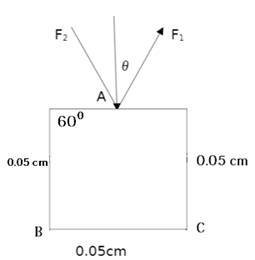
Also force on A =
resultant ![]()
![]()
![]()
=24.94N
Solution 17
Net Force of D is given as
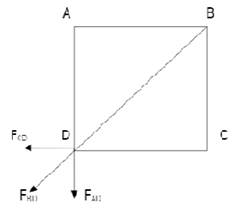
=![]() +0
+0
![]()
![]()
=19.49N
Now, resultant force is
![]()
![]()
![]()
Solution 18
We know ,
F = ![]()
![]()
![]()
Solution 19
From previous solution
![]()
Now,
![]()
![]()
![]()
![]()
![]()
Solution 20
Force on ![]() and
and ![]() particle is given as:
particle is given as:
![]()
![]()
![]()
![]()
![]()
![]()
![]()
![]()
![]()
![]()
![]()
Solution 21
We know,
![]()
![]()
![]()
Solution 22
(a) Electric Force is
given as : F = ![]()
![]()
(b) Resultant force on
it along the string , ![]() =0as T
=0as T![]()
Mg balances each other.
Resultant force on it perpendicular to the string
![]()
![]()
![]()
(c) Radial component is given as :
![]()
![]()
![]()
![]()
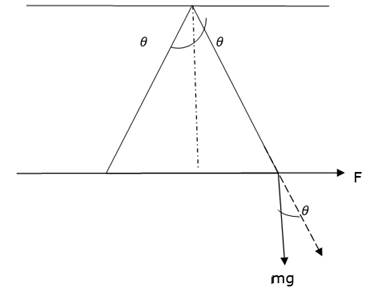
(d) Accelaration is given as:
![]()
![]()
a = 0.95m/![]()
Solution 23
![]()
![]()
Also F=m![]()
![]()
![]()
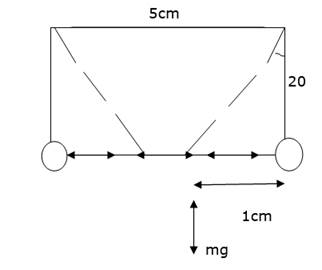
And tension T = mg![]()
![]()

![]()
Solution 24
We know,
T![]() ___1
___1
T![]()
On dividing we get,
![]() =
= ![]()
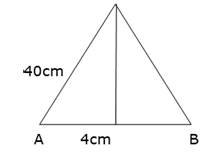
![]()
![]()
q = 4.123![]()
Elecrtric Field and Potential Exercise 122
Solution 25
![]()
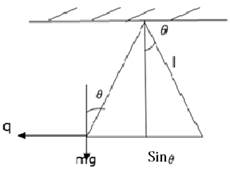
In case of equilibrium;
![]()
![]()
![]()
![]()
![]()
![]()
Solution 26
T = m![]()
= 0.1![]() 9.8 =0.98N
9.8 =0.98N
Now for T = 0, charge will repel the bob.
T- mg+F=0
T=mg
![]()
![]()
![]()
Solution 27
Particles A and B remain at rest after C is to be clamped
Thus , net force on C is :
![]() = 0____1
= 0____1

And ![]()
![]()
![]()
Now from equation 1
![]()
Solution 28
Force between ![]() is given as :
is given as :
![]()
![]()
= 36![]() N
N
Also , F =-kx
![]()
![]()
Solution 29
B is at equilibrium
![]()
![]()
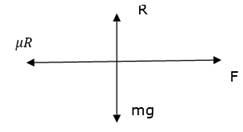
![]()
![]()
Solution 30
Force is given by :
![]()
Also, ![]() [In case of equilibrium ]
[In case of equilibrium ]
![]()
![]()
r = 2.709![]() m
m
Solution 31

Net force is given as:
![]()
= 2![]()
![]()

![]()
For force to be maximum ![]()
![]()
On solving we get
![]()
And ![]()
![]()
Solution 32
(a) According to figure,
![]()
And force on point o due to vertical component is given :
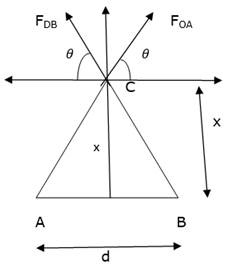
![]()
![]()
![]()

![]()
![]()
(b) Now when x<



Solution 33

![]()
And
![]()
Net force is given as :
![]()
![]()
![]()
![]()
![]()
And acceleration is given as :
![]()
and time period is :


![]()
Solution 34
Electric field is given as :
![]()
![]()
Solution 35
For E = 0,
![]()
![]()
![]()
![]()
![]()
![]()
![]()
Solution 36
![]()
![]()
![]()
Solution 37
We know , qE = mg
![]()
E = 66.6N/C
Solution 38
Electric field at centre is given as:

E = 0
![]()
![]()
Potential is given as:
![]()
![]()
Solution 39
Electric field at P is given as:
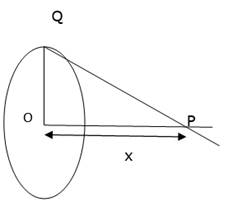
= ![]() [ AS R>>x)
[ AS R>>x)
Force is given as :
F = Q![]() E
E
![]()
And time is given as:


Solution 40
Electric field at centre is :

![]()
Horizontal component
balances ![]()
And vertical component is given as:
![]()
![]()
![]()
![]()
![]()
Integrating
![]()
![]()
Also
![]() )
)
![]()
Solution 41
Electric field for charged cylinder 1s given as :
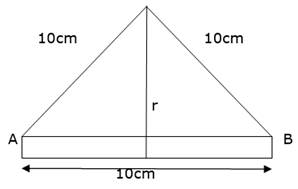
![]()

![]()
Solution 42
Electric field at point say P (which is at x distance ) is given as :
![]()
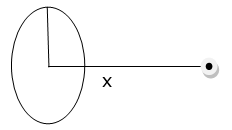
For maximum electric field :
![]()
![]()
![]()
![]()
Solution 43
Regular hexagon is an equipotentential surface Thus charge at every point on surface is same.
Therefore, Net electric field at centre is zero.
Solution 44
When charge was distributed uniformly, then net electric field E=0.
Now , when dl is cut off then electric field is given as :
![]()
![]()
![]()
Solution 45
Electric field is given as :
![]()
![]()
![]()
Solution 46
According to figure :
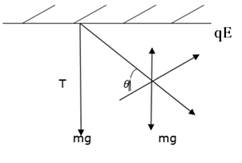
![]()
![]()
![]()
![]()
Or ![]()
Now ,
![]()
Also from equation 1
![]()
![]()
![]()
![]()
Solution 47
Force experienced by particle is :
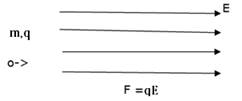
And ![]()
As the particle comes to
rest , thus it experiences deacceleration , of ![]() and so, distance
courred is given as :
and so, distance
courred is given as :
![]()
![]()
Solution 48
(a) Force F = qE
![]()
F = 3N
And acceleration
![]()
![]()
![]()
Now, ![]()
![]()
![]()
(b) We know,
![]()
![]()


![]()
(c)
Also ![]()
![]()
![]()
![]()
v = 49m/s
(d)Work done is given as:
W =Fs
![]()
W =1.2J
Elecrtric Field and Potential Exercise 123
Solution 49
(a)We know,
![]()
![]()
And resultant Force is :
![]()
![]()
![]()
![]()
![]()
![]()
![]()
![]()
![]()
Thus, path is straight
line at an angle of 45![]() with horizontal.
with horizontal.
(c) vertical
displacement ![]() =
= ![]()
![]()
Horizontal displacement
![]()
![]()
![]()
=19.6m
Net displacement is given as :
![]()
![]()
S = 27.7m
Solution 50
As given
20 oscillation = 45s
Oscillation ![]()
Thus , time period when electric field is not applied is given as:


![]()
Now, electric field is applied pointing upwards. Thus time period focus:

Where.
ma = qE
![]()

T = 2.59
Now for 20 oscillations
:![]()
= 51.85
![]()
Solution 51
Force is given as:
F =qE
And F = -ka [ where a is amplitude]
![]()
![]()
Solution 52
In this case when block is going towards wall, acceleration is along some direction as displacement But when is going away from wall then acceleration is in opposite direction as displacement.
Thus block does not follow SHM.
Now we know,
![]()
![]()

total time T =2t


Solution 53
Electric field is given as :
![]()
V = Er
![]()
V=5V
Solution 54
We know ,
Work done W = Potential
diff ![]() charge
charge
![]()
![]()
![]()
![]()
Solution 55
Let third charge be![]() .
.

When it is placed at P:
![]()
![]()
![]()
When it is placed at Q:
![]()
![]()
![]()
Solution 56
Potential difference ![]()
a) When A =(0,0)and B = (4m,2m)
![]()
![]()
=80V
b) When A = (4m,2m) and B = (6m,5m)
![]()
= 40V
c) When A = (0,0) and (6m,0m)
![]()
=120V
Solution 57
Electric field acts along x - axis.
Thus , potential difference is given as
: ![]()
And, potential energy is
![]()
![]()
![]()
Points (0,0) and (4,2)
![]()
![]()
=-80V
And,
![]()
![]()
![]()
![]()
Points (4m,2m) and (6m,5m)
![]()
![]()
=-40V
And
![]()
![]()
![]()
![]()
Points (0,0) and (6m,5m)
![]()
![]()
=-120V
And ,
![]()
![]()
![]()
![]()
Solution 58
Electric field is given as :
![]()
And ![]()
![]()
![]()
![]()
![]()
V = -100V
Solution 59
We know,
![]()
![]()
![]()
V = 500volts
Solution 60
a) As given :
V(x,y,z) = A(xy + yz + xz)
So, dimensions of A = ![]()
![]()
[![]() ]
]
b) Electric field
![]()
![]() -
-![]()
=-[A(y+z)![]() A(x+z)
A(x+z)![]() +A(y+z)
+A(y+z)![]()
![]()
![]()
![]()
![]()
E = 34.6N/C
![]()
Solution 61
Potential energy PE is given as:
![]()
![]()
![]()
P.E. = 36J
Solution 62
a) From given figure (a):
![]()
![]()
![]()
change in electric potential is :
![]()
![]()
![]()
![]()
![]()
![]()
![]()
![]()
(b) From figure :
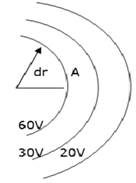
Angle
![]()
Potential is given as :
![]()
![]()
Kq = 6 1
Now, electric field is :
![]()
![]()
Direction of electric field is radically outward.
Solution 63
Electric potential

![]()
![]()
![]()
![]()
![]()
Solution 64
a) Potential difference V = Exdx
= 1000![]()
V = 20volts
b) We know F= ma=qE
![]()
![]() /
/![]()
Now we know
![]()
![]() = 2
= 2![]()
![]()
Now ![]()
![]()
And also
![]()
![]()
![]()
![]()
![]()
S = 0.50cm
Elecrtric Field and Potential Exercise 124
Solution 65
(a) Potential difference is
![]()
integrating
![]()
![]()
(b) Fro equation 1
V =-2x
![]()
![]()
![]()
(c) If ![]()
then , ![]()
![]()
![]()
(d) Now if ![]() =0
=0
then,
![]() -
-![]()
![]()
![]()
![]()
![]()
![]()
![]()
![]()
Solution 66
Net potential energy is given as :
![]()
![]()
![]()
![]()
![]()
![]()
Solution 67
Change in K.E. = Work done
10= (![]() )
)![]()
![]()
![]()
![]()
Solution 68
Force is given as :
![]()
![]()
![]()
![]()
![]()
a ![]() /
/![]()
Now , we know ,
![]()
![]()
![]()
![]()
![]()
![]()
Solution 69
Force is given as :
![]()
![]()
![]()
Also F =ma
![]()
![]()
![]() /
/![]()
Now we know
![]()
![]()
![]()
![]()
V = ![]()
![]()
V![]()
Solution 70
Maximum torque is given as :
![]()
![]()
![]()
Solution 71
a) Dipole moment , ![]()
![]()
![]()
b) Electric field at axial point is
![]()
![]()
![]()
c) Electric field at a point perpendicular is
![]()
![]()
![]()
Solution 72
Dipole moment , P =q![]() d
d
At A, -q is placed
At B , 2q is placed
At c , -q is placed
60![]() A-q
A-q
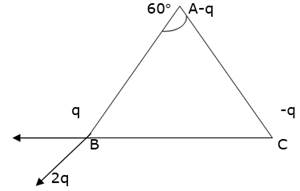
![]()
![]()
![]()
![]()
Solution 73
(a) P =2qa ![]()
(b) According to figure :
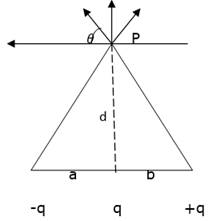
![]()
![]()
![]()
![]()
![]()
![]()
![]()
![]()
(c) In this case ![]()
![]()

![]()
Solution 74
In case of simple pendulum :

And ![]()
![]()
From 1
Dividing From m,


Solution 75
In case of copper
![]()
![]()
![]()
![]()

